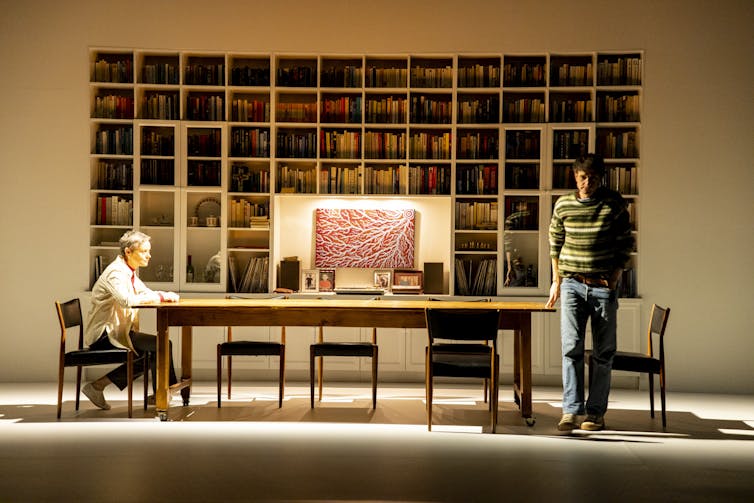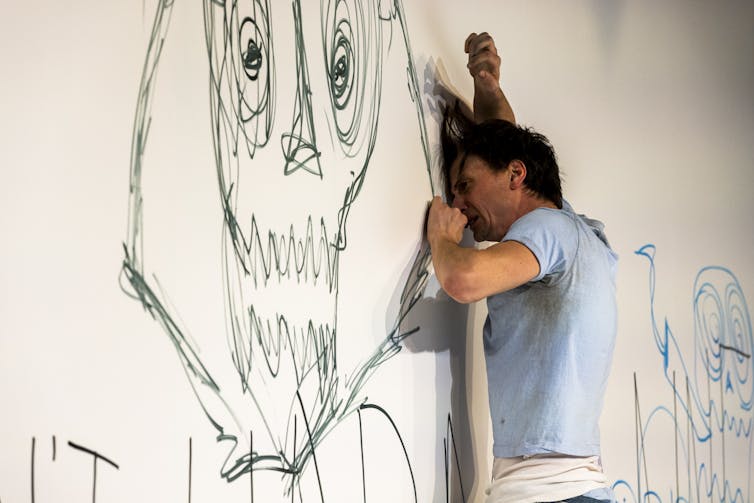
Review: Tell Me I’m Here, directed by Leticia Cáceres, Belvoir.
Released in 1991, the memoir Tell Me I’m Here remains a landmark examination of the experience of mental illness in Australia. Journalist Anne Deveson offered a raw and painful account of her eldest son Jonathan’s experience with schizophrenia, her family’s attempts to weather the storms of his illness, and her research into the condition.
In his mother’s memoir, Jonathan is funny and loving. He also has terrifying episodes of psychosis. He hits his mother and spits at his siblings. He cycles through the mental health and criminal justice systems, multiple times.
It is not, as you can imagine, a story with a happy ending.
Deveson’s candour was enormously important in helping to destigmatise mental illness. In transforming her unbearable tragedy into memoir, she performed a powerful act of empathy and advocacy. At the book’s close she wrote:
For too long, mental illness has been kept in the shadows. Instead of rejection, we need acceptance. Instead of shame, we need love. Instead of despair, we need solid and unwavering support. It is time to come out of the shadows and into the light.
Deveson spent the rest of her life trying to bring mental illness into the light through her media work and her involvement with the Schizophrenia Australia Foundation, now known as SANE Australia.
This stage adaptation extends Deveson’s legacy of public advocacy for a new audience.
Adapted by Veronica Nadine Gleeson and directed by Leticia Cáceres, it is a vivid and deeply moving theatrical experience.
Electrifying
The staging (set design by Stephen Curtis) is spare and inventive. An elegant set of shelves full of books and a large dining table signify this is the home of an educated middle-class family.

The play begins with Jonathan’s birth and early years, deftly staged. The bond between mother and son is quickly established.
At the time of her son’s first serious episode of ill-health, Deveson had recently divorced from her children’s father, the journalist Ellis Blain (a droll performance by Sean O’Shea).
With her three children, Anne had moved to Adelaide to start a new relationship, but in effect, she was a single mother who had to travel overseas to make documentaries about famines and war zones to support her family.

In the demanding lead role of Anne, Nadine Garner captures Deveson’s elegant, patrician voice, her no-nonsense appearance, as well as her warmth, wit and love. The play relies heavily on Deveson’s narration, maintaining a brisk pace. In this, it resembles the Joan Didion play The Year of Magical Thinking: both are stories of tragedy, both adapted from memoirs, both centre on a woman’s experience.
While Didion’s play is a one-woman show, in Tell Me I’m Here Anne shares the stage with others.

This is the great advantage and benefit of moving the story from page to stage: while Deveson offered a powerful portrait of Jonathan in her book, Tom Conroy’s embodiment of Jonathan on stage is, simply, electrifying.
Alternately vulnerable and frightening, he and Garner fight and rage, but also have a tender, loving relationship, beautifully conveyed by the performers.
Read more: Looking after loved ones with mental illness puts carers at risk themselves. They need more support
Terrifying and achingly sad
In the play’s opening scenes, Jonathan draws a large rectangle on the stage. It is the shape and size of a grave. For those who know this story, it foreshadows what is to come. For those who don’t, the shape is quickly obscured by the other doodles and drawings Jonathan makes on the stage. The graffiti he draws on the walls is a powerful visualisation of his psychosis.
At one despairing moment, he writes “Don’t Harm Anne” in large letters. It is at once terrifying and achingly sad.

Anne struggles to get Jonathan the help he needs, often without success. A doctor tells a police officer at her house there is “no such thing as schizophrenia”; Jonathan’s medication has awful side-effects which encourage him to abandon it.
The play shows how the entire family suffered as they grappled with the unpredictability of Jonathan’s ill-health. Georgia (Jana Zvedeniuk), in particular, rails against the ways her brother consumes all her mother’s time and energy.
Yet the play also conveys the terror and torment Jonathan endured, as, in Deveson’s words, he suffered “the loss of his promise, the loss of himself”.
Affirmation and recognition
In 1991, Tell Me I’m Here struck a chord with many Australians. In Anne Deveson’s personal papers, held at the National Library of Australia, there are thick folders of anguished letters from people who had similar experiences.
Telling her story helped ease the burden of shame so many felt about mental illness.
This play tells Anne and Jonathan’s story for a new audience, and a different time.
It is tragic the story remains so relevant, more than 30 years later.

For anyone who has experienced the frustration and torment of supporting a loved one while they struggle with mental illness, Tell Me I’m Here will offer affirmation and recognition.
In the play’s closing moments, it even offers hope. It is a wrenching and beautiful work.
Tell Me I’m Here is at Belvoir until September 25.
If this article has raised issues for you or you’re concerned about someone you know, call Lifeline on 13 11 14.
Michelle Arrow is currently receiving funding from the Australian Research Council to write a biography of Anne Deveson.
This article was originally published on The Conversation. Read the original article.







